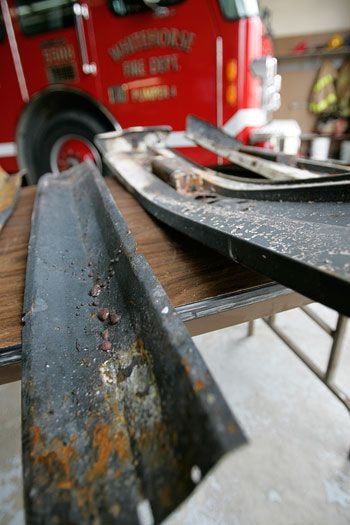A bolt of lightning burned down the abandoned warehouse at Third Avenue and Black Street, investigators have revealed.
Arson was initially suspected in the June 11 fire.
Vagrants had been known to occupy the dilapidated property, and one door to the building was open when the fire department arrived.
“Those factors made the fire initially suspicious in nature and so that’s why the RCMP were contacted to assist with the investigation,” said Whitehorse fire Chief Clive Sparks.
As police and firefighters combed the wreckage, a piece of melted copper caught their eye.
Copper doesn’t melt until it reaches 1,000 degrees Celsius, but temperatures in a building fire rarely exceed 800 degrees.
That’s when fire officials began to suspect an electrical fire.
Copper wire can be melted by an electrical short, which could have sparked and ignited the building.
But visits from Yukon Electrical technicians confirmed that the building hadn’t held electrical power for years.
“That left a bit of a puzzle for us,” said Warren Zakus, the fire department’s chief training officer.
As officials combed through other parts of the burned warehouse, they started to discover more hotspots littered with fused wiring.
“The extent of the damage was far beyond what would exceed any sort of normal, electrical malfunction,” said Zakus.
“That was when we first started raising the suspicion that it could possibly have been a lightning strike,” he said.
After all, there had been lightning in the area prior to the fire, and an old building with lots of rooftop metal would have been a perfect target.
Firefighters found more and more evidence the building was devastated by something far more powerful than an arsonist’s match.
Fluorescent lights were found blown out with the metal components completely evaporated.
Wires had been instantaneously reduced into pools of beaded copper.
Photographs submitted by the public revealed that the warehouse had actually hosted two fires that night.
Far from the main action, a tiny rooftop fire had also been burning.
“The fact that there were two fires in two different parts of the building at the same time—there’s really only a couple of options with that,” said Zakus.
Either an arsonist lit the building’s interior on fire, and then climbed onto the roof to start another fire, or a bolt of lightning struck the building.
After sending evidence to some firefighters in BC and Manitoba, lightning was pegged as the culprit.
“Lightning-caused strikes are pretty rare for us,” said Zakus.
“I don’t recall, in the 40 years I’ve been doing this, ever discovering a lightning-caused fire in the city,” said Sparks.
As lightning strikes go, the Black Street warehouse got off easy.
“It was either a very weak lightning strike, or a fork that shot off a main lightning strike,” said Zakus.
Direct, full-bore lightning strikes can have explosive potential.
Zakus recalled a lightning-caused fire that threw chunks of metal into nearby trees.
Contact Tristin Hopper at tristinh@yukon-news.com
